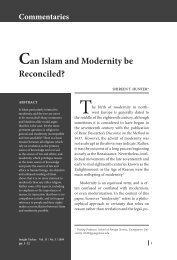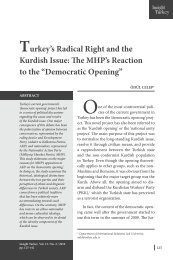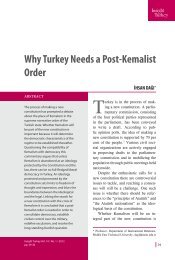Culture of Co-existence in Islam: The Turkish Case
Culture of Co-existence in Islam: The Turkish Case
Culture of Co-existence in Islam: The Turkish Case
Create successful ePaper yourself
Turn your PDF publications into a flip-book with our unique Google optimized e-Paper software.
ALİ BARDAKOĞLU<br />
Only a handful <strong>of</strong> people <strong>in</strong><br />
the West associate <strong>Islam</strong> with<br />
peace; the great majority, on<br />
the contrary, associate this<br />
global religion <strong>of</strong> over one<br />
billion followers with violence,<br />
terrorism and authoritarianism<br />
<strong>of</strong> different cultures and religions. <strong>The</strong><br />
Qur’an as the major source <strong>of</strong> Muslim<br />
theology provides us with extensive<br />
<strong>in</strong>sights as far as other Abrahamic religions<br />
are concerned. <strong>The</strong> Qur’an clearly<br />
<strong>in</strong>dicates that <strong>Islam</strong> is the cont<strong>in</strong>uation<br />
<strong>of</strong> Judaism and Christianity whose followers<br />
are described as ‘People <strong>of</strong> the<br />
Book’ (ahl al-Kitab), and whose sacred<br />
texts are also accepted as revealed<br />
sources. When <strong>Islam</strong> was revealed <strong>in</strong> the seventh century, it did not proclaim itself<br />
a completely new and different faith, but rather a reaffirmation <strong>of</strong> Abrahamic<br />
tradition. 4 Likewise, the Prophet Muhammad was declared not as the first or only<br />
prophet, but as the last circle <strong>of</strong> the prophetic cha<strong>in</strong>s. Although the Qur’an noted<br />
theological differences between <strong>Islam</strong> and these religions, it made a general call<br />
address<strong>in</strong>g all <strong>of</strong> humanity. Followers <strong>of</strong> Judaism and Christianity were not forced<br />
to convert to <strong>Islam</strong> when Muslims held political might, as the Qur’an made it very<br />
clear: <strong>in</strong> <strong>Islam</strong> ‘there is no compulsion <strong>in</strong> matters <strong>of</strong> faith’ (2: 256). <strong>Islam</strong> claims to<br />
be the last and most perfected religion (5: 3), but it values free <strong>in</strong>dividual choice<br />
to believe or disbelieve. Although <strong>Islam</strong> has declared itself a universal religion,<br />
neither the Prophet nor the followers <strong>of</strong> this faith started to spread the message <strong>of</strong><br />
<strong>Islam</strong> with the assumption that all <strong>of</strong> humanity would necessarily become Muslims.<br />
Naturally however, the Prophet hoped that the message <strong>of</strong> <strong>Islam</strong> as the last<br />
revealed religion would be accepted by free will. As far as social, cultural, and<br />
religious formations are concerned, both theory and practice <strong>in</strong> Muslim history<br />
demonstrate that <strong>Islam</strong> has recognized diversity and pluralism as a natural human<br />
condition. This is stated <strong>in</strong> the Qur’an as follows: ‘Had your Lord willed, all<br />
the people on Earth <strong>in</strong> their entirety would have believed. Would you force the<br />
people to make them believe’ (10: 99). In a different verse, the importance <strong>of</strong> <strong>in</strong>dividual<br />
choice is <strong>in</strong>dicated <strong>in</strong> the call: “so let he who will believe, and let he who<br />
will disbelieve” ( 18: 29). <strong>The</strong>se verses acknowledge that human be<strong>in</strong>gs have always<br />
followed different religious beliefs and practices throughout history, and that these<br />
differences may also persist <strong>in</strong> the future. It is on these pr<strong>in</strong>ciples that, <strong>in</strong> the formative<br />
<strong>of</strong> period <strong>of</strong> <strong>Islam</strong>, the foundations for manag<strong>in</strong>g diversity were laid down.<br />
<strong>The</strong> document known as the Med<strong>in</strong>a <strong>Co</strong>venant, dat<strong>in</strong>g back to 662 B.C.E., <strong>in</strong>cludes<br />
<strong>in</strong>junctions regulat<strong>in</strong>g relations between Muslims, Jews and the people <strong>of</strong><br />
Med<strong>in</strong>a. Although the textual sources <strong>of</strong> <strong>Islam</strong> provide normative, general rules<br />
and pr<strong>in</strong>ciples <strong>in</strong> matters <strong>of</strong> religious beliefs and practices, some references deal-<br />
114







